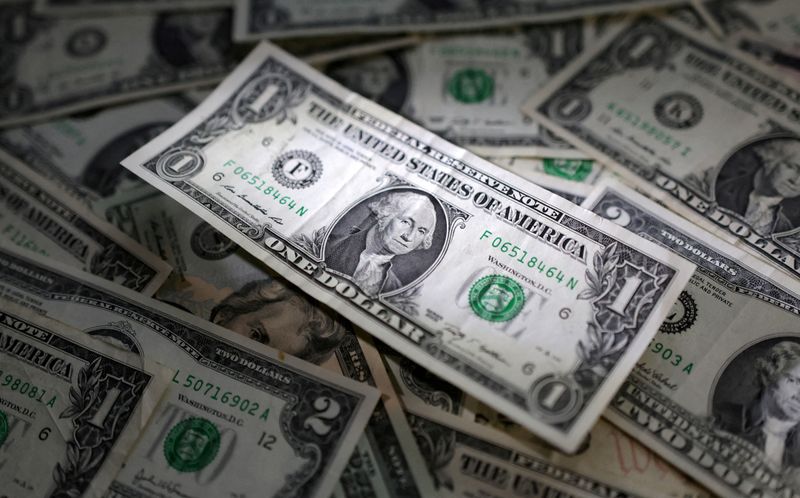By Gertrude Chavez-Dreyfuss
NEW YORK (Reuters) - The dollar fell for a second straight session on Thursday after a mixed, but overall solid batch of U.S. economic data, which is unlikely to stop the Federal Reserve from cutting interest rates by June, the first since the pandemic.
The U.S. dollar index was last down 0.4% at 104.28. Against the yen, the dollar slid 0.4% to 149.92.
Traders are once again watching dollar/yen as it topped 150 in the last few days, a critical level that puts the market on alert for possible intervention by Japan to weaken its currency.
The yen firmed despite Japan's unexpectedly weak gross domestic product figures, which saw the country lose its title as the world's third-largest economy to Germany.
In the United States, data showed retail sales, unadjusted for inflation, fell 0.8% in January, much lower than an expected decline of 0.1% based on a Reuters poll. The data was likely weighed down by winter storms.
Unadjusted retail sales in general fall in January. Economists had cautioned before the data release not to read too much into any sharp drop.
"The market remains focused on day-to-day data prints at this stage, but I don't think anything has really changed much," said Brad Bechtel, global head of FX at Jefferies in New York.
"We did get pretty far into the market pricing in a no-landing scenario, pricing out rate cuts to further out in the year. That was unwound a little bit."
Bechtel added that the dollar overall is consolidating the recent run-up after a relatively extended period of strength, over 5% on the year.
A separate report showed initial claims for state unemployment benefits fell 8,000 to a seasonally-adjusted 212,000 for the week ended Feb. 10. This is further evidence that the U.S. labor market remains tight.
Another piece of data showed U.S. industrial production last month slid to a weaker-than-expected -0.1%, the lowest since October.
However, the Empire State manufacturing index improved to -2.4 in February, after sinking to -43.7 in January, the lowest reading since May 2020.
In the same token, the Philadelphia Fed manufacturing index rose to 5.2 in February, well above expectations, after rising to -10.6 in January. February's print was the highest since the 7.7 figure hit in August.
Even with those decent U.S. numbers, the dollar slumped. Against the Swiss franc, the greenback sagged 0.6% to 0.8798 francs.
The euro gained 0.4% to $1.0768, while sterling climbed 0.3% to $1.2595.
Thierry Albert Wizman, global rates and FX strategist at Macquarie in New York, said the dollar's pullback was likely temporary.
"As long as ... this divergence continues between U.S. outperformance and the rest of the world, there's no reason the dollar's momentum will reverse anytime soon," he added. "We will continue to see the dollar stay strong and maybe extend a little further."
The federal funds futures market sees the first rate easing happening at the June meeting, with an 83% probability, according to LSEG's rate probability app.

Rate futures have also priced in between three to four rate cuts this year, down from about five a few weeks ago.
(This story has been corrected to say rising, instead of slipping, in the headline)